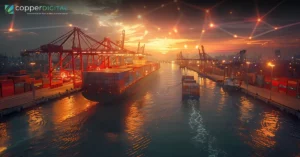In the dynamic and constantly changing world of global commerce, the upcoming year, 2024, is poised to mark a crucial turning point for businesses, particularly in the Australia and New Zealand (ANZ) region. As we stand at the threshold of a new era, it’s crucial for supply chain leaders not just to anticipate change but to orchestrate it seamlessly.
Amidst the dynamic arena where innovation, resilience, and adaptability converge to redefine the very fabric of supply chain strategies, our blog transcends the mundane and propels you into a realm where foresight meets actionable insights.
As we delve into the core, expect to uncover strategies that go beyond conventional wisdom. This isn’t just about surviving; it’s about thriving amidst uncertainty. From the rise of sustainable practices to the digital transformation imperative, our roadmap unveils a tapestry of opportunities waiting to be woven into the narrative of your business success.
So, join us as we dissect the pulse of ANZ supply chains in 2024, providing you with the compass you need to navigate through the complexities that lie ahead. This isn’t just a roadmap; it’s your strategic guide to triumph in the competitive landscape of tomorrow.
Also, Read – How Supply Chain Digitization Drives Agility and Resilience in Industry 4.0
Key Supply Chain Challenges 2024
In the current business landscape, distributors are grappling with an array of challenges and trends that demand both resilience and innovation. Let’s dissect these key factors shaping the future of supply chains:

Energy Cost Pressures Persist
Distributors find themselves in a continuous battle against rising energy costs, necessitating vigilance and innovation. As the costs of fuel and transportation escalate, the ripple effect extends to all aspects of operations and customer services. Adapting strategies to mitigate these impacts is imperative for maintaining operational efficiency and customer satisfaction.
Economic Uncertainties Continue
Amidst interest rate hikes and the lingering impacts of the pandemic, economic uncertainties persist. Distributors must differentiate themselves by offering value-added services and leveraging technology efficiently. Flexibility and adaptability become pivotal as the economic landscape evolves, prompting the need for agile adjustments to products, services, and marketing strategies.
Inventory Challenges Persist
Companies grapple with inventory challenges, oscillating between shortages and excess stock. Just-in-case inventory methodologies gain traction, albeit tying up capital. To navigate these challenges, proper demand planning and advanced technologies like AI and ML have become indispensable. Creating supplier redundancy helps maintain uninterrupted inventory flow amid disruptions.
Talent Shortage Remains
The ongoing talent shortage, spanning high and low-skilled positions, requires a focus on positive company cultures. Prioritizing work-life balance and leveraging technology for efficient and secure remote access becomes paramount. Automation of routine tasks enhances job satisfaction and overall productivity.
Regulatory Compliance Challenges
Navigating the intricate web of ever-changing regulations poses a significant challenge for distributors. Compliance requirements vary across regions, industries, and products, leading to potential disruptions and legal complications. Investing in regulatory intelligence systems and fostering close collaborations with legal experts help ensure adherence to compliance standards and minimize legal risks.
Transportation Bottlenecks and Delays
Distributors encounter bottlenecks and delays in transportation, impacting the timely delivery of goods. Factors such as traffic congestion, border regulations, and unexpected disruptions contribute to this challenge. Implementing dynamic route optimization software and fostering partnerships with reliable carriers enhance the efficiency of transportation operations, mitigating delays and improving overall delivery timelines.
Supply Chain Cybersecurity Threats
The increasing digitization of supply chain processes exposes distributors to cybersecurity threats. Malicious actors target sensitive data, leading to potential breaches that can disrupt operations and compromise sensitive information. Investing in robust cybersecurity measures, including encryption, regular audits, and employee training, is crucial to fortify the supply chain against cyber threats.
Demand Volatility and Forecasting Accuracy
Fluctuations in consumer demand pose challenges for distributors trying to accurately forecast inventory needs. Rapid shifts in market trends, consumer preferences, and external factors contribute to demand volatility. Leveraging advanced analytics, machine learning algorithms, and collaborative forecasting tools assists in improving accuracy and agility in responding to dynamic demand patterns.
Environmental Sustainability Imperatives
The growing emphasis on environmental sustainability places additional pressures on distributors to adopt eco-friendly practices. Reducing carbon footprints, optimizing packaging materials, and implementing sustainable sourcing strategies become integral components of supply chain management. Collaboration with suppliers committed to sustainable practices and continuous assessment of eco-friendly alternatives contribute to meeting environmental sustainability goals.
Also, Read – Navigating the Ethical Challenges of Digital Supply Chain Management
Top 7 Supply Chain Trends Dominating ANZ in 2024-25: A Deep Dive
While automation and e-commerce dominate headlines, several lesser-known trends are silently shaping the future of ANZ’s supply chains. Here’s a deeper dive into these trends, exploring their potential impact and implications:

1. Sustainable Packaging Revolution: A Green Odyssey
Beyond just compliance, the ANZ region is witnessing a sustainable packaging revolution, driven by:
- Consumer Demand: Eco-conscious consumers are demanding environmentally responsible packaging solutions, pushing businesses to innovate.
- Regulatory Push: Governments are implementing stricter regulations to promote sustainable practices, further accelerating the shift.
Expect to see:
- Edible Coatings: Imagine fresh produce wrapped in a protective, edible layer that eliminates plastic waste.
- Bioplastics: Derived from renewable resources like algae or microorganisms, these innovative materials offer a sustainable alternative to traditional plastics.
- AI-powered Packaging Optimization: Utilizing artificial intelligence to analyze product characteristics and design the most efficient packaging possible, minimizing material usage and waste generation.
2. Blockchain Beyond the Hype: Building Trust, One Block at a Time
Move over, buzzwords. Blockchain is transitioning from a theoretical concept to real-world applications in ANZ supply chains, focusing on:
- Enhancing Traceability: Imagine tracking the journey of ethically sourced goods, from mine to market, ensuring conflict-free minerals or sustainable seafood. This transparency builds trust with consumers who are increasingly concerned about ethical sourcing.
- Combatting Counterfeiting: Blockchain’s immutable ledger system can track goods throughout the supply chain, making it virtually impossible to introduce counterfeit products, protecting both businesses and consumers.
3. The Rise of “Friendshoring”: A Collaborative Approach
The traditional debate of nearshoring vs. onshoring is evolving into a nuanced approach called “friendshoring”:
- Strategic Partnerships: Businesses are forging alliances with reliable regional partners like Vietnam or Indonesia, leveraging their proximity, complementary strengths, and shared commitment to ethical and sustainable practices.
- Building Resilience: This collaborative approach aims to create a resilient and sustainable supply chain network, reducing reliance on single-source suppliers and mitigating the risks associated with global disruptions.
4. Hyper-Personalization at Warp Speed: The Customer is King (and Queen, and…)
Customer expectations in ANZ are not just evolving; they’re hyper-evolving. Supply chains need to become personalization powerhouses:
- Automated Systems: Imagine AI-powered systems analyzing vast amounts of customer data to predict preferences and tailor product offerings or fulfillment strategies in real time.
- Data-Driven Decisions: Businesses will leverage data analytics to personalize marketing campaigns, recommend relevant products, and offer customized delivery options, all at an unprecedented speed.
5. E-commerce Warehousing Goes Granular: Delivering the “I Want It Now” Experience
It’s not just about warehouses anymore. The e-commerce boom demands a shift to micro-fulfillment centers:
- Strategic Positioning: These smaller, strategically located centers are positioned within densely populated areas, enabling same-day or even hyper-local deliveries.
- Faster Fulfillment: This granular approach significantly reduces delivery times, exceeding customer expectations and offering a competitive edge in the fast-paced e-commerce landscape.
6. From Skills Gap to Skills Leap: The Future-Proof Workforce
The skills gap in the ANZ supply chain industry isn’t just being addressed, it’s being leapfrogged:
- Upskilling and Reskilling Programs: Businesses are investing in comprehensive training programs tailored to emerging technologies like AI, automation, and data analytics.
- Attracting New Talent: Alongside upskilling existing employees, companies are actively recruiting talent with the necessary skills to navigate the digital future of supply chains.
7. Data-Driven Decisions, not Data Graveyards: Unlocking the Power of Insights
Businesses are moving beyond data collection. They’re transforming it into actionable insights through advanced analytics:
- Predictive Maintenance: Imagine leveraging data to predict equipment failures before they occur, preventing costly downtime and ensuring smooth operations.
- Optimized Inventory Management: Data analytics can help businesses optimize inventory levels, reducing carrying costs and ensuring product availability to meet customer demand.
- Real-Time Risk Mitigation: Advanced analytics can be used to identify potential disruptions in the supply chain, allowing businesses to take proactive measures and minimize their impact.
Bonus Supply Chain Trends
- Rise of AI and Automation: The recognition of technology’s value is fueling a surge in digital transformation across industries. Distributors must continuously invest in automation and AI to remain competitive. Lagging behind can hinder the ability to adapt to industry changes and meet evolving customer expectations.
- Cloud-based Computing Adoption: Enhancing Security, Scalability, and Data Analysis: The migration to cloud-based computing is gaining momentum, offering enhanced security, scalability, and data analysis capabilities. This trend is driven by the rising threat of cyberattacks and the need for businesses to optimize IT resources for improved customer experience and cost-effectiveness.
- Continued E-commerce Growth: Demanding Investment in Technology for Smooth Operations: The e-commerce boom continues to place strain on distribution networks. To streamline operations and enhance customer experience, distributors must invest in technology, including well-designed websites, active social media presence, and efficient online stores.
- Sustainability: Consumers Pressuring Companies to Reduce Environmental Impact: Consumer demands for sustainability are pushing distribution companies to reduce their environmental footprint. Implementing economically sound and environmentally friendly practices, such as reducing energy consumption and adopting renewable energy sources, is becoming crucial for businesses seeking to align with evolving consumer expectations.
These trends are not just individual developments; they are interconnected forces shaping the future of ANZ’s supply chains. By understanding these trends and their potential impact, businesses can gain a competitive edge, navigate the complex landscape of the coming years, and thrive in the dynamic world of supply chain management.
In the End!
From persistent energy challenges to economic uncertainties, the call for digital transformation has never been clearer. As technology accelerates and e-commerce continues its ascent, distributors must invest wisely in robust digital infrastructures to thrive.
Talent shortages and inventory complexities underscore the need for adaptable strategies, emphasizing positive company cultures and leveraging advanced technologies. Sustainability, now a consumer mandate, pushes distributors to reevaluate their environmental impact, making eco-friendly practices a strategic imperative.
In this transformative era, challenges are opportunities in disguise. For those charting a course into the future, partnering with a renowned digital transformation services company is key. Such partnerships provide the expertise to navigate uncertainties, capitalize on innovations, and ensure sustained success in the digital landscape.
As we move forward, let innovation guide supply chain leaders toward a future where resilience, adaptability, and cutting-edge technology converge for unparalleled growth.



